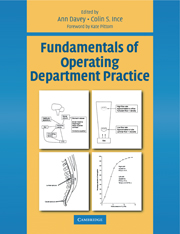Book contents
- Frontmatter
- Contents
- Contributors
- Preface
- Foreword
- Acknowledgements
- Introduction
- Chapter 1 The operating department practitioner, the patient and the law
- Chapter 2 Aspects of health and safety in the operating department
- Chapter 3 The caring practitioner
- Chapter 4 Strategies for infection control in the operating department
- Chapter 5 Sterilization, decontamination and the surgical field
- Chapter 6 The fundamentals of cardiovascular physiology
- Chapter 7 Fundamentals of respiratory physiology
- Chapter 8 Scientific principles in relation to the anaesthetic machine
- Chapter 9 Fundamentals of artificial ventilation of the lung
- Chapter 10 Scientific principles in relation to monitoring equipment
- Chapter 11 Scientific principles in relation to endoscopic, laser and radiological equipment
- Chapter 12 Pharmacological principles of drug administration
- Chapter 13 The pharmacology of drugs used in general anaesthesia
- Chapter 14 The local anaesthetic drugs - does the ideal agent exist?
- Chapter 15 The safe positioning of patients for surgery
- Chapter 16 Principles involved in the management and use of equipment
- Chapter 17 Understanding suture materials
- Chapter 18 Fundamentals ofpaediatric surgery and anaesthesia
- Chapter 19 Fundamentals of hyperthermia and hypothermia
- Chapter 20 Fundamentals of fluid and electrolyte balance during surgery
- Chapter 21 The physiology of blood and its administration
- Chapter 22 Fundamentals of pain relief
- Chapter 23 Fundamentals of dressings and drains in relation to wound healing
- Chapter 24 The recovery of patients from anaesthesia and surgery
- Chapter 25 Fundamentals of emergency and obstetric anaesthesia
- Chapter 26 Identification and management of anaesthetic emergencies
- Chapter 27 The fundamentals of emergency resuscitation
- Appendixes
- Index
Introduction
Published online by Cambridge University Press: 05 October 2015
- Frontmatter
- Contents
- Contributors
- Preface
- Foreword
- Acknowledgements
- Introduction
- Chapter 1 The operating department practitioner, the patient and the law
- Chapter 2 Aspects of health and safety in the operating department
- Chapter 3 The caring practitioner
- Chapter 4 Strategies for infection control in the operating department
- Chapter 5 Sterilization, decontamination and the surgical field
- Chapter 6 The fundamentals of cardiovascular physiology
- Chapter 7 Fundamentals of respiratory physiology
- Chapter 8 Scientific principles in relation to the anaesthetic machine
- Chapter 9 Fundamentals of artificial ventilation of the lung
- Chapter 10 Scientific principles in relation to monitoring equipment
- Chapter 11 Scientific principles in relation to endoscopic, laser and radiological equipment
- Chapter 12 Pharmacological principles of drug administration
- Chapter 13 The pharmacology of drugs used in general anaesthesia
- Chapter 14 The local anaesthetic drugs - does the ideal agent exist?
- Chapter 15 The safe positioning of patients for surgery
- Chapter 16 Principles involved in the management and use of equipment
- Chapter 17 Understanding suture materials
- Chapter 18 Fundamentals ofpaediatric surgery and anaesthesia
- Chapter 19 Fundamentals of hyperthermia and hypothermia
- Chapter 20 Fundamentals of fluid and electrolyte balance during surgery
- Chapter 21 The physiology of blood and its administration
- Chapter 22 Fundamentals of pain relief
- Chapter 23 Fundamentals of dressings and drains in relation to wound healing
- Chapter 24 The recovery of patients from anaesthesia and surgery
- Chapter 25 Fundamentals of emergency and obstetric anaesthesia
- Chapter 26 Identification and management of anaesthetic emergencies
- Chapter 27 The fundamentals of emergency resuscitation
- Appendixes
- Index
Summary
Major advances in anaesthesia and surgery may only occur when the understanding of a principle or discovery is linked to its practical application and the potential usefulness of this development is realized. Even then, progress is limited by the technical ability of the time.
Thus, before the discovery of anaesthesia surgery was generally limited to amputations, the removal of bladder stones, the repair of fistulas and fairly superficial operations. Celcus, a Roman physician in AD 30, was probably the first to remove a bladder stone and the procedure changed little over 1800 years. This type of surgery was, however, made respectable when, in 1686, Charles François removed a stone from Louis XIV by cutting into the perineum.
The Massachusetts General Hospital in Boston only recorded 43 operations from 1821 to 1823 because the real prospect of death and the incredible pain suffered meant that only hopeless cases or patients in severe distress would consider the risk worthwhile. Surgeons therefore tried to introduce instruments into the bladder in order to crush these stones. Jean Civiale experimented on cadavers and on his own bladder stone. In 1823 he used forceps introduced through the urethra to hold his stone which was then drilled, causing it to break into pieces. His record showed that it was virtually painless.
Without anaesthesia, surgeons needed to practise with skill and speed. Susruta, an Indian physician in the 5th century AD, recorded the first operation for nasal reconstruction. A similar operation was performed on a bullock driver by a Mahratta surgeon, using a forehead skin flap modelled on a wax reconstruction of the nasal defect. This was first published in “The Gentleman's Magazine” in October 1794. Joseph Carpue, who trained at St George's Hospital London, researched the method and performed his first operation that lasted 37 minutes on October 23 1814.
Major developments in surgery only became possible with the discovery that inhaling certain chemical gases could produce insensitivity to pain. The possibility had existed for over 300 years because in 1540 Valerius Cordus used ether to successfully anaesthetize and then recover chickens. Joseph Priestly discovered nitrous oxide in 1772 and in 1800 Sir Humphry Davy used it to relieve the pain of an infected tooth.
- Type
- Chapter
- Information
- Fundamentals of Operating Department Practice , pp. 1 - 8Publisher: Cambridge University PressPrint publication year: 1999



